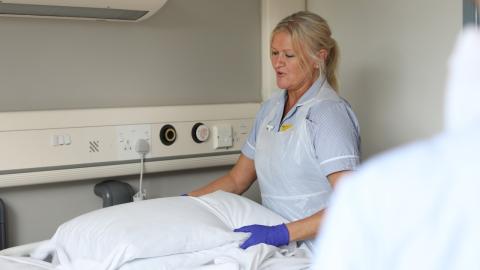
Registered Nurse Verification of Expected Adult Death guidance (RNVoED)

The Care After Death: Registered Nurse Verification of Expected Adult Death (RNVoEAD) Guidance provides a framework for the timely verification of expected adult deaths by experienced registered nurses (who have been assessed as competent).
Contributors include a wide range of senior healthcare professionals.
Title
What's on this page
About this publication
Aims of the guidance
This guidance ensures that a death is dealt with:
- in line with the law and coroner requirements
- in a timely, sensitive, and caring manner
- respecting the dignity, religious and cultural needs of the patient and family members as far as is practicable
- ensuring the health and safety of others, e.g. from infectious illness including COVID-19, radioactive implants, and implantable devices.
How to use the guidance
We anticipate that local areas will develop their own policies based on the guidance, but sensitised to the local area, enabling staff to care appropriately for the deceased, supporting and minimising distress for families and carers at any time of the day, night or week. This guidance has been developed in line with the person and family centred care recommendations in national documents.
This guidance may be used to inform training for other registered healthcare professionals who are regulated by a professional body who, under statutory regulation, are recognised by the Professional Standards Authority.
Competency Assessment
A competency assessment tool accompanies this guidance for Registered Nurses (RNs) to demonstrate their practical skills, knowledge and understanding for verifying an expected adult death. RNs already competent in verification of an expected adult death are not expected to repeat the competency assessment, rather to familiarise themselves with the changes within this guidance and adopt the changes into their practice.
Supported by
- Hospice UK
- National Nurse Consultant Group (Palliative Care)
- Royal College of General Practitioners
Version control
| Date | Version | Reason |
| 29 September 2025 | 6.2 | Text added in: Uncontrolled when printed. This document is maintained electronically. The printed version of this document is not controlled and may be out of date. For the most current and official version, please refer to the Hospice UK website. |
| 11 June 2025 | 6.2 | Contributors list updated (page 22). |
| 20 May 2025 | 6.2 |
Reference added in re: motor/ cerebral response Page 3: “Families should be advised that there might be a difference between the time of the last breath and the official time of death” changed to “Families should be advised that there will be a difference between the time of the last breath and the official time of death”. Page 6: “The RN should know the medical legal responsibilities” changed to “The RN must know the medical legal responsibilities”. Page 7: definition of the Coroner added in. Page 9: note referring to minimising contamination removed. Page 9: new box added to procedure to rule out suspicious circumstances. |
| 20 December 2024 | 6.1 | Removed from page 5: “The death can be verified even if the doctor has not seen the patient in the previous 28 days.” |
| 15 October 2024 | 6.1 | Legislation has changed, September 2024. A medical practitioner is no longer required to have seen the deceased within 28 days. |
| 2 April 2024 | 6.0 |
References to COVID all removed. Role of the Medical Examiner added in (applicable from April 2024). Paragraph on Non Invasive Ventilation added in. |
| 18 April 2023 | 5.1 |
Page 10; Motor / Cerebral Response After five minutes of continued cardio-respiratory arrest, test for the absence of motor response with the trapezius squeeze or the absence of cerebral activity with supra orbital pressure, which is considered best practice. To ensure there are no signs of motor or cerebral activity. In line with: Academy of Medical Royal Colleges. A code of practice for the diagnosis and confirmation of death: 2025 update. London: Academy of Medical Royal Colleges; 2025. |
Updated in October 2025 by Hospice UK and National Nurse Consultant Group (Palliative Care).
Published by Hospice UK in April 2022.


